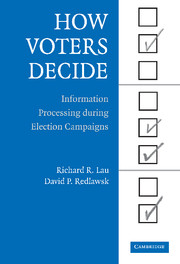Book contents
- Frontmatter
- Contents
- List of Tables and Figures
- Acknowledgments
- HOW VOTERS DECIDE
- I Theory and Methods
- II Information Processing
- 5 What Voters Do – A First Cut
- 6 Individual Differences in Information Processing
- 7 Campaign Effects on Information Processing
- III Politics
- IV Conclusion
- Appendix A Detailed Examples of Decision Strategies in Action
- Appendix B How the Dynamic Information Board Works
- Appendix C Overview of Experimental Procedures
- Appendix D Detailed Decision Scripts
- Appendix E Calculating the On-line Evaluation Counter
- References
- Index
- Titles in the series
7 - Campaign Effects on Information Processing
Published online by Cambridge University Press: 05 September 2012
- Frontmatter
- Contents
- List of Tables and Figures
- Acknowledgments
- HOW VOTERS DECIDE
- I Theory and Methods
- II Information Processing
- 5 What Voters Do – A First Cut
- 6 Individual Differences in Information Processing
- 7 Campaign Effects on Information Processing
- III Politics
- IV Conclusion
- Appendix A Detailed Examples of Decision Strategies in Action
- Appendix B How the Dynamic Information Board Works
- Appendix C Overview of Experimental Procedures
- Appendix D Detailed Decision Scripts
- Appendix E Calculating the On-line Evaluation Counter
- References
- Index
- Titles in the series
Summary
The previous chapterprevious chapter looked at how differences among voters – their general political sophistication, their political predispositions, and their education, gender, and age – affect information processing and choice strategies. All these characteristics are things voters carry around with them, as they live through actual political campaigns, and as they showed up to participate in our experiments. In this chapter, we turn to exploring how differences between campaigns influence those same variables. In particular, we will examine how the number of candidates running in an election, their ideological distinctiveness, the candidates' fit with partisan stereotypes, whether the candidate supported during the primary is running in the general election, the resources they have available to buy television advertising, and the timing of their ads during the campaign, all affect information processing and choice strategies. The first three of these factors clearly involve the difficulty of the choice facing the voter, the instantiation of the “nature of the decision task,” which completes the initial stage of our framework for studying decision making (Figure 2.1).
NUMBER OF CANDIDATES RUNNING IN AN ELECTION
Three of our studies manipulated the number of candidates running in a primary election campaign. And we have already seen in Chapter 5, one of the important consequences of this manipulation is the amount of search devoted to each candidate. Look back at Figure 5.2. It is easy to see that voters' information processing is strongly affected by this manipulation.
- Type
- Chapter
- Information
- How Voters DecideInformation Processing in Election Campaigns, pp. 135 - 154Publisher: Cambridge University PressPrint publication year: 2006

